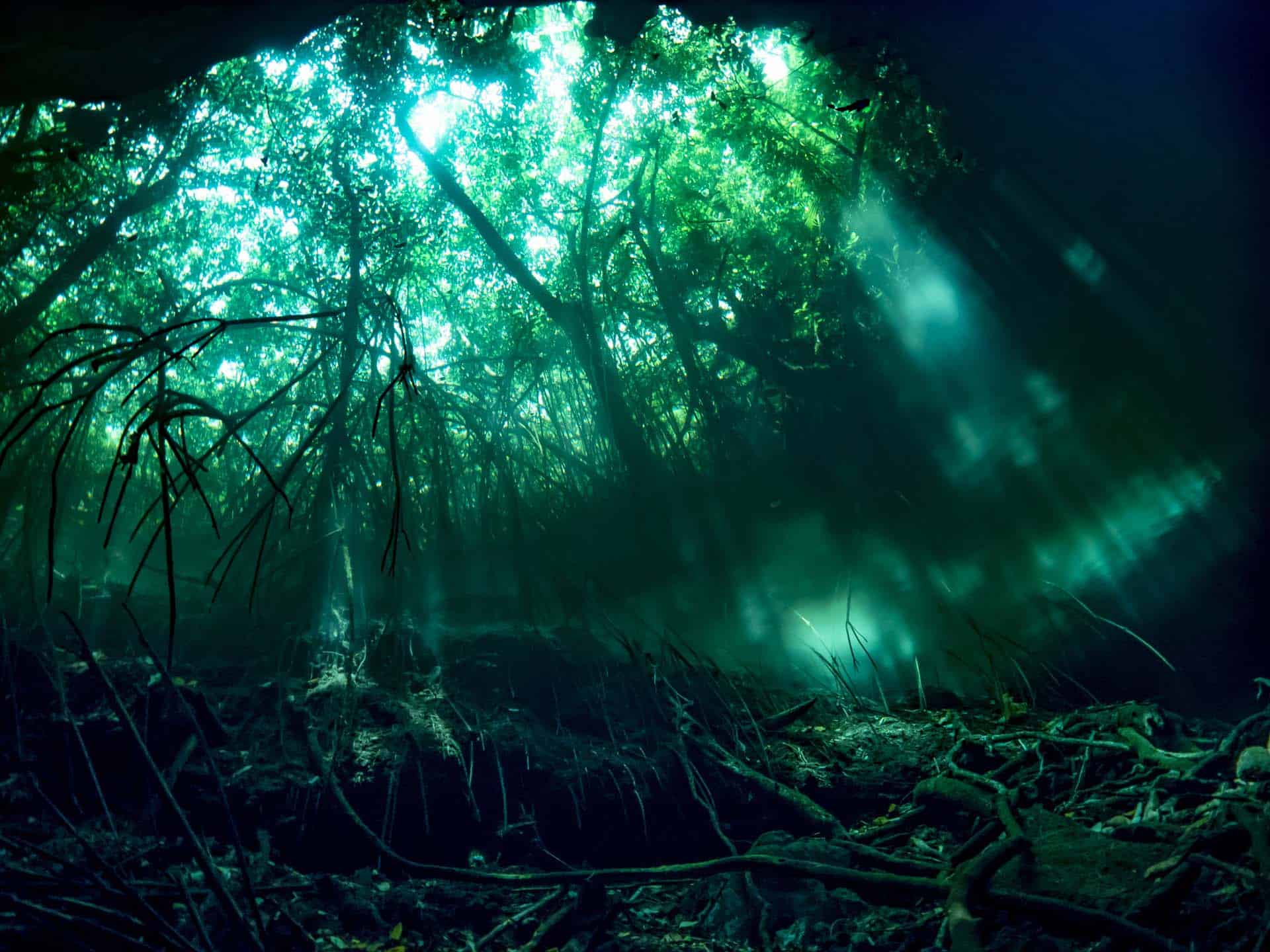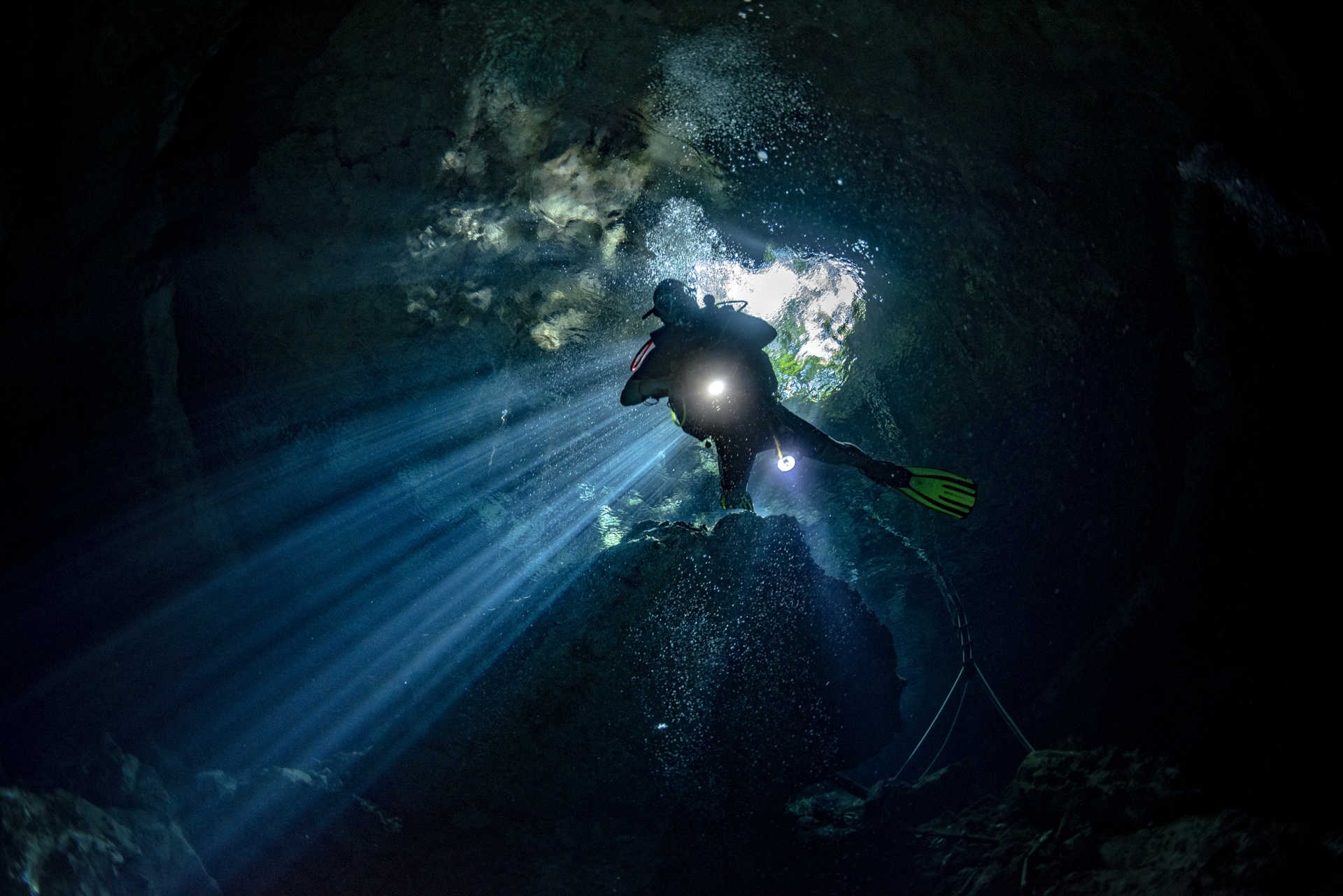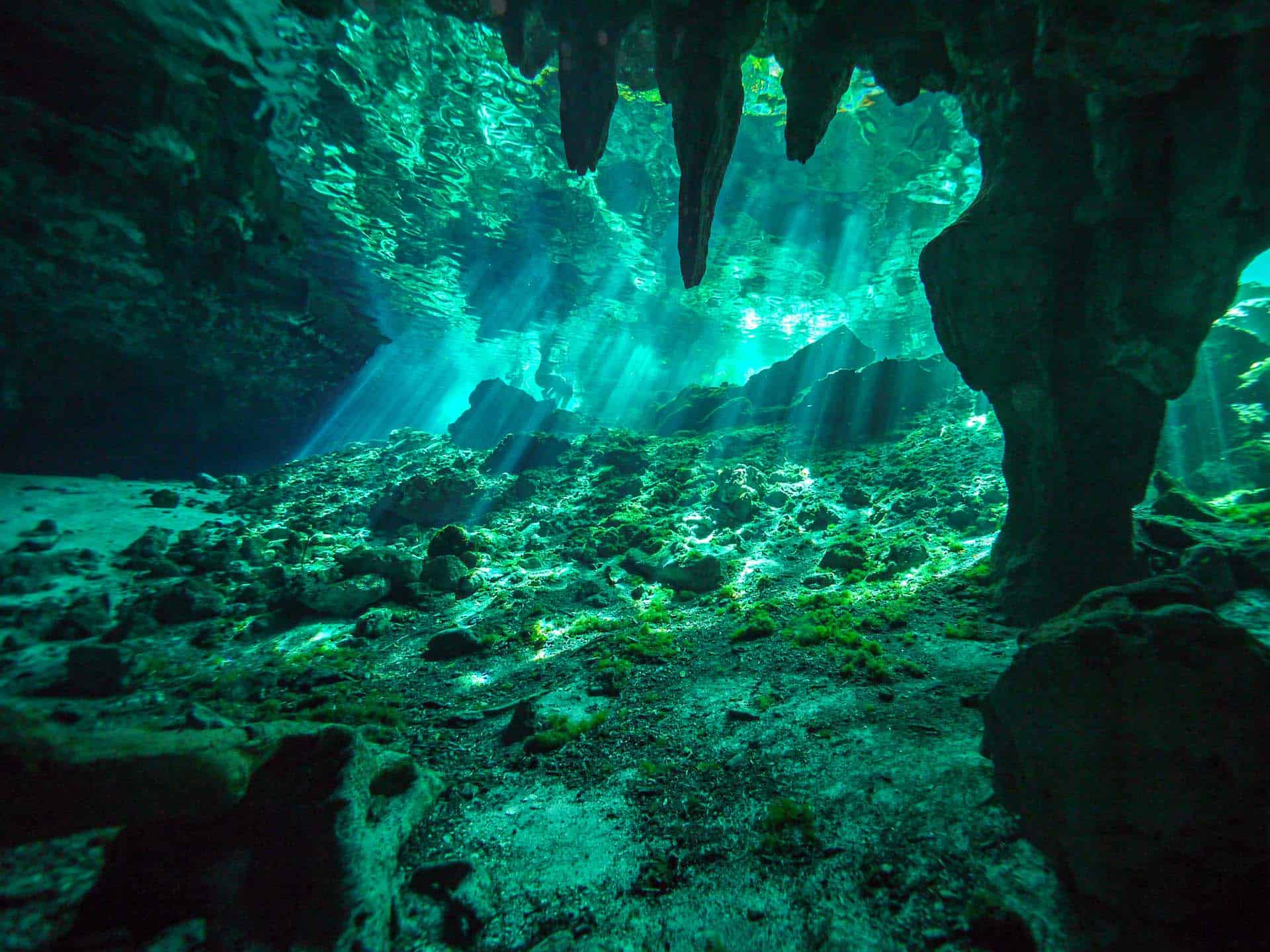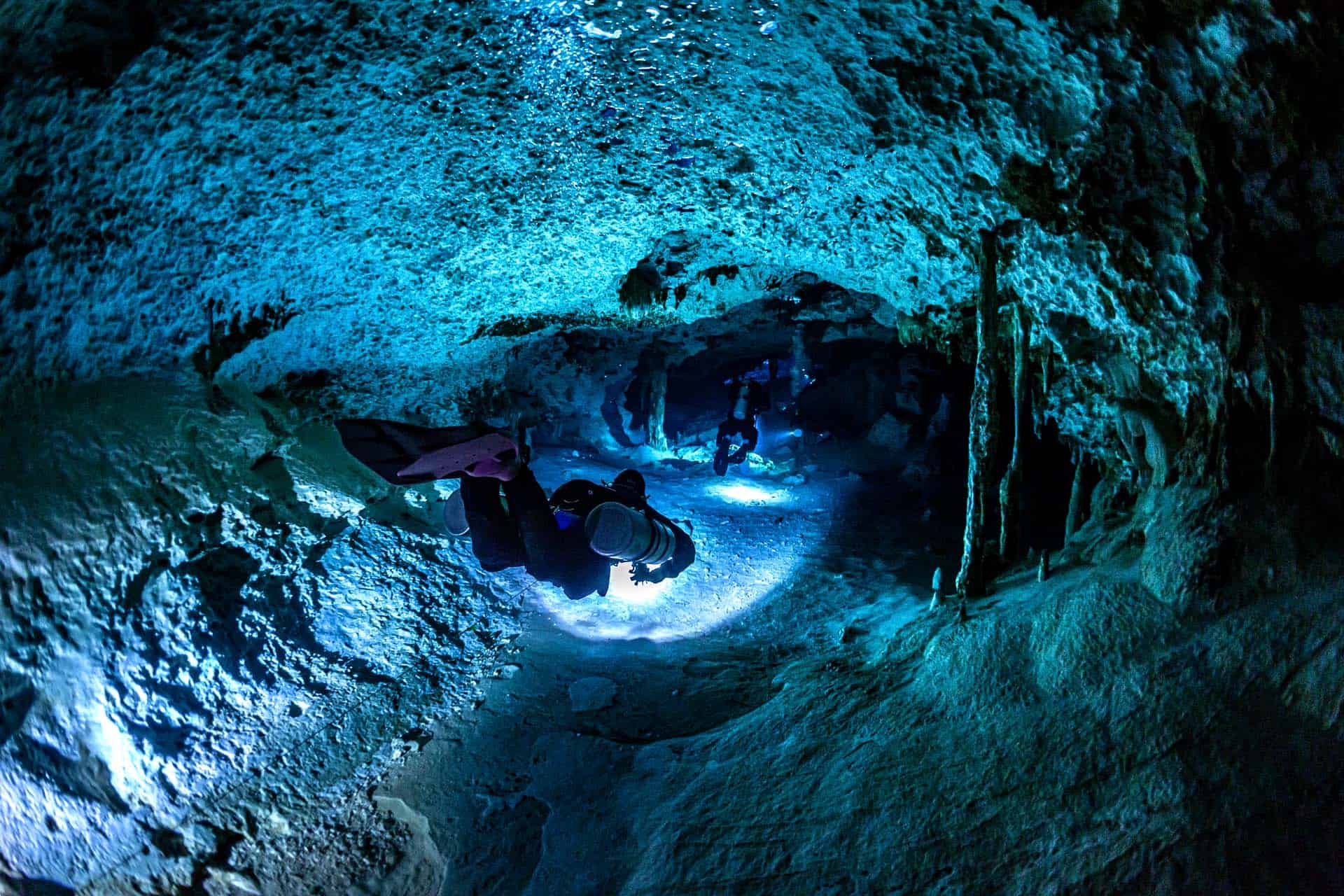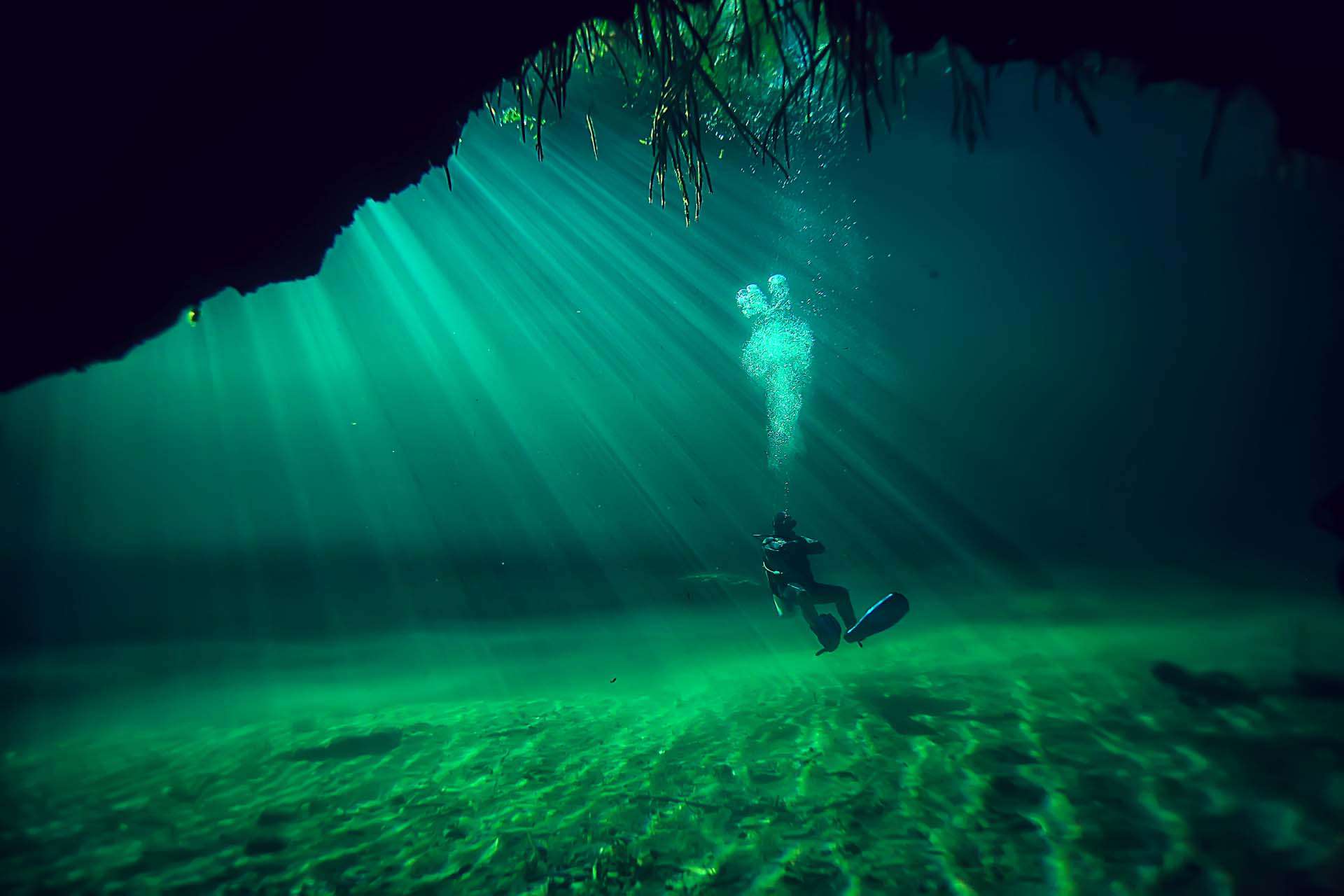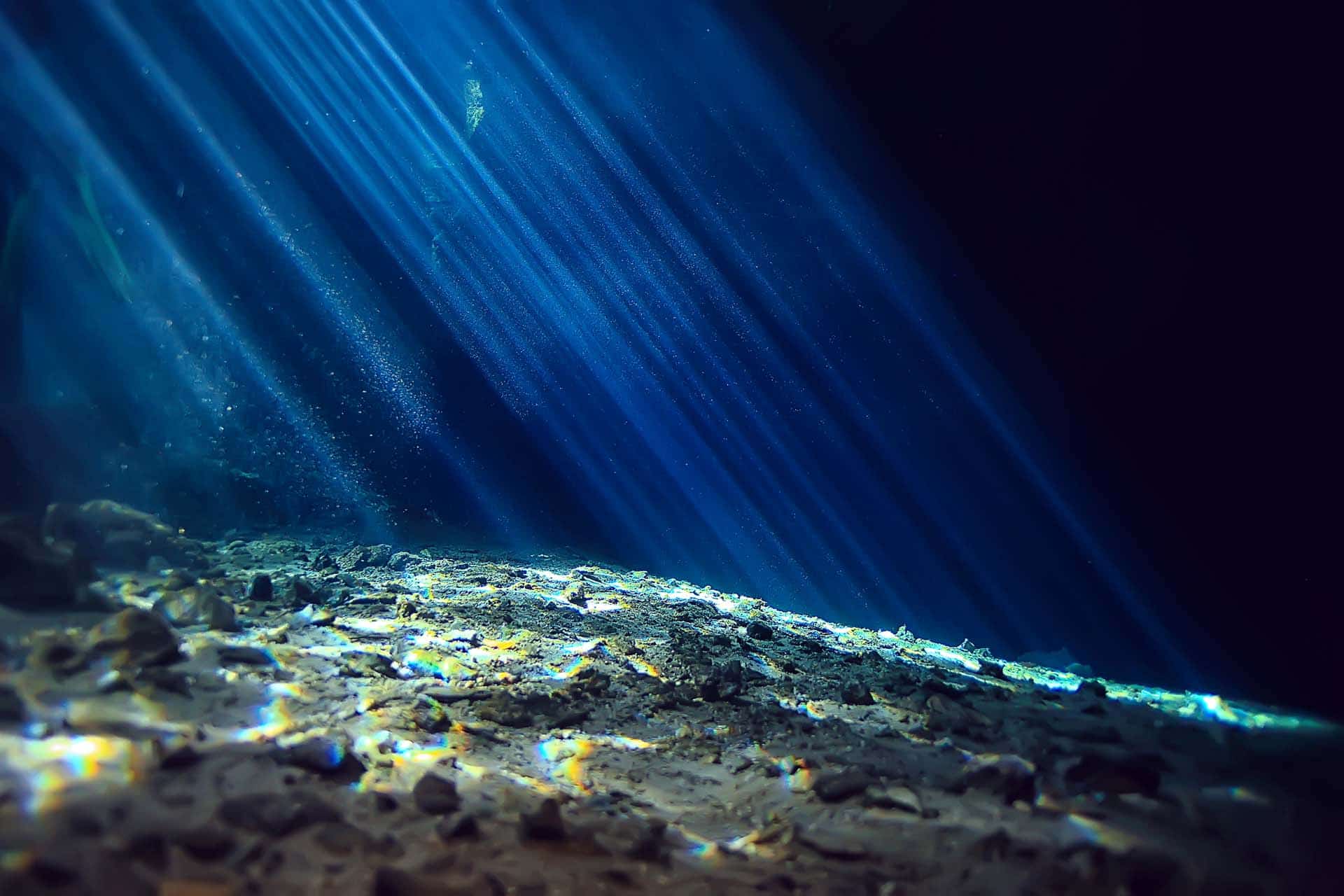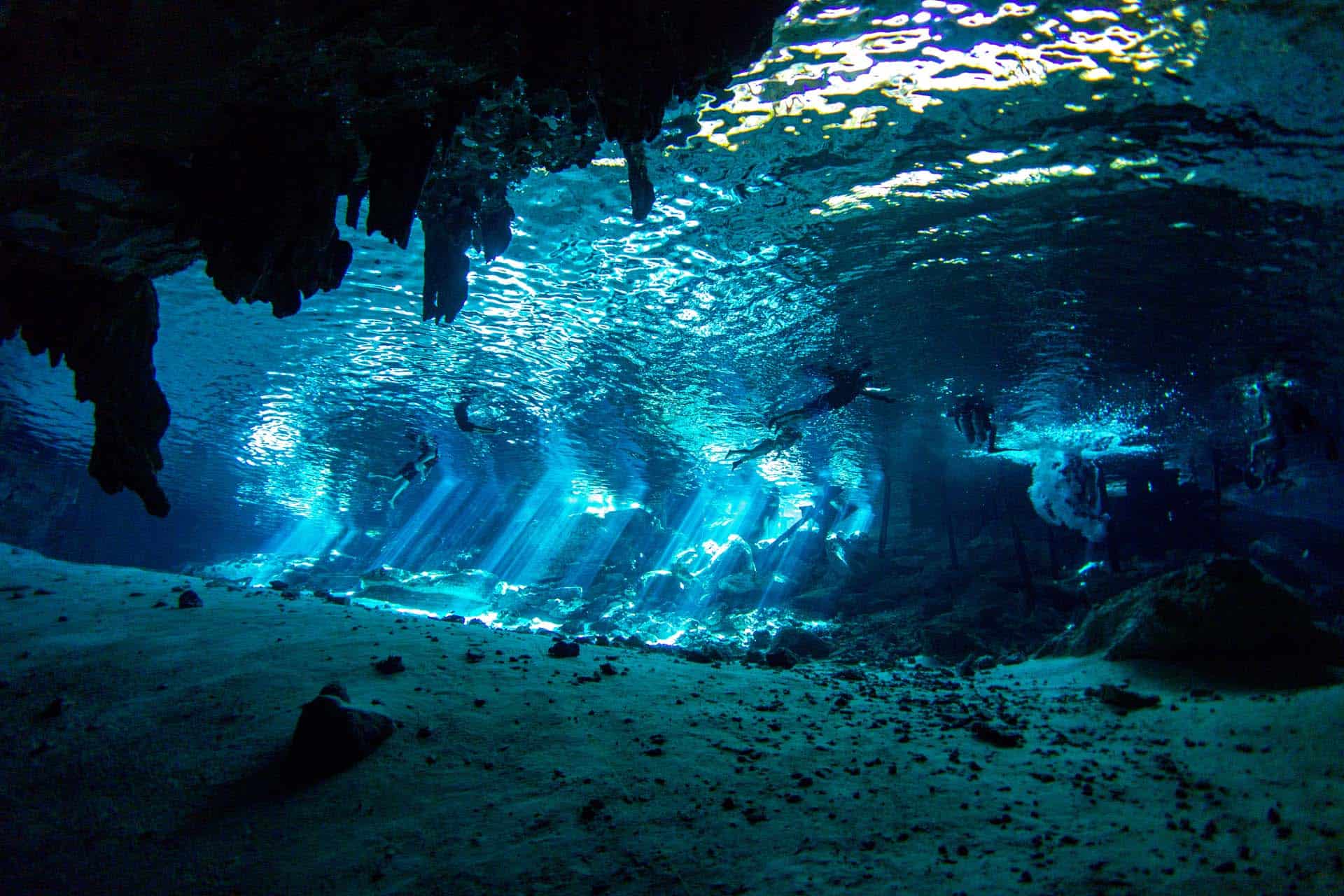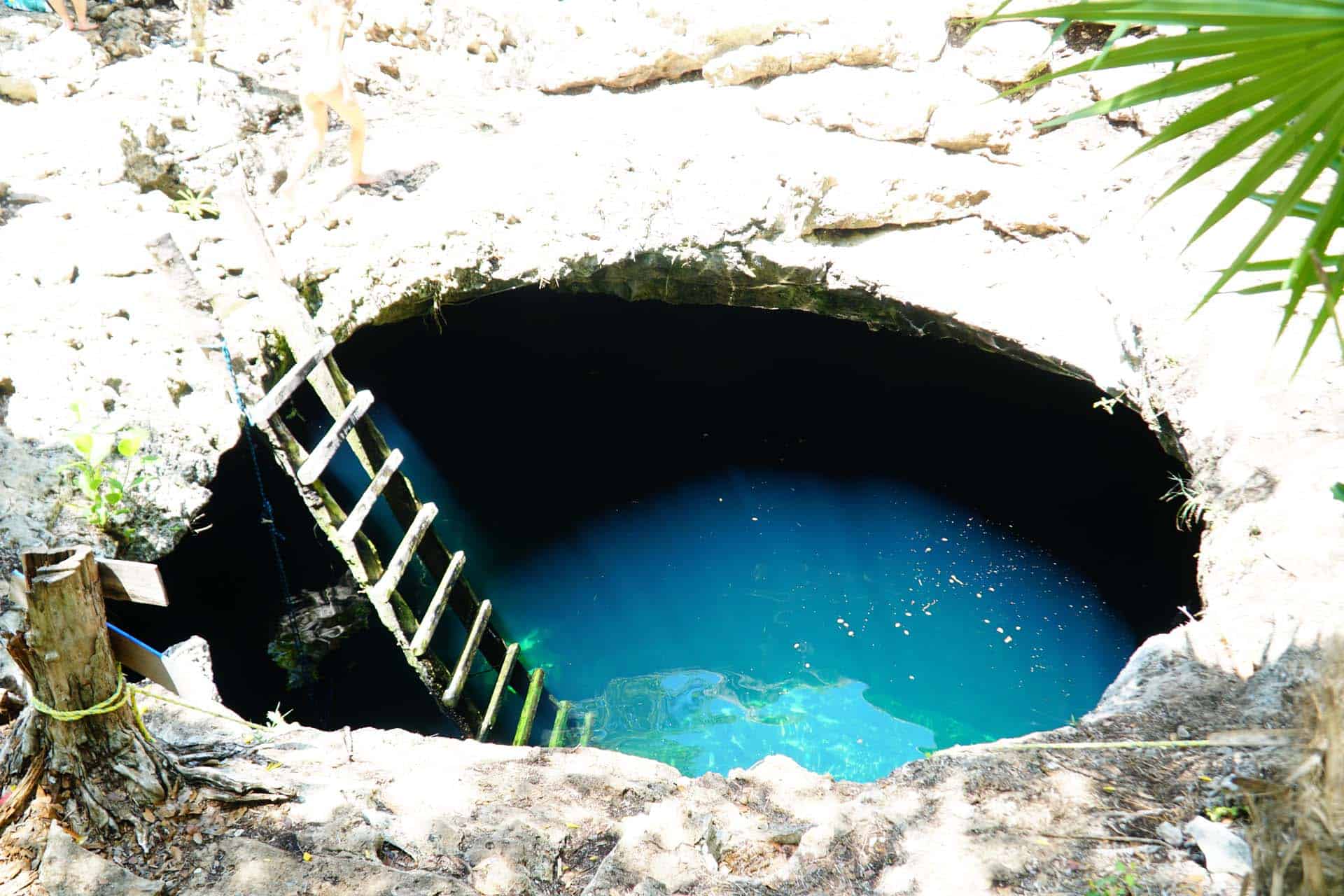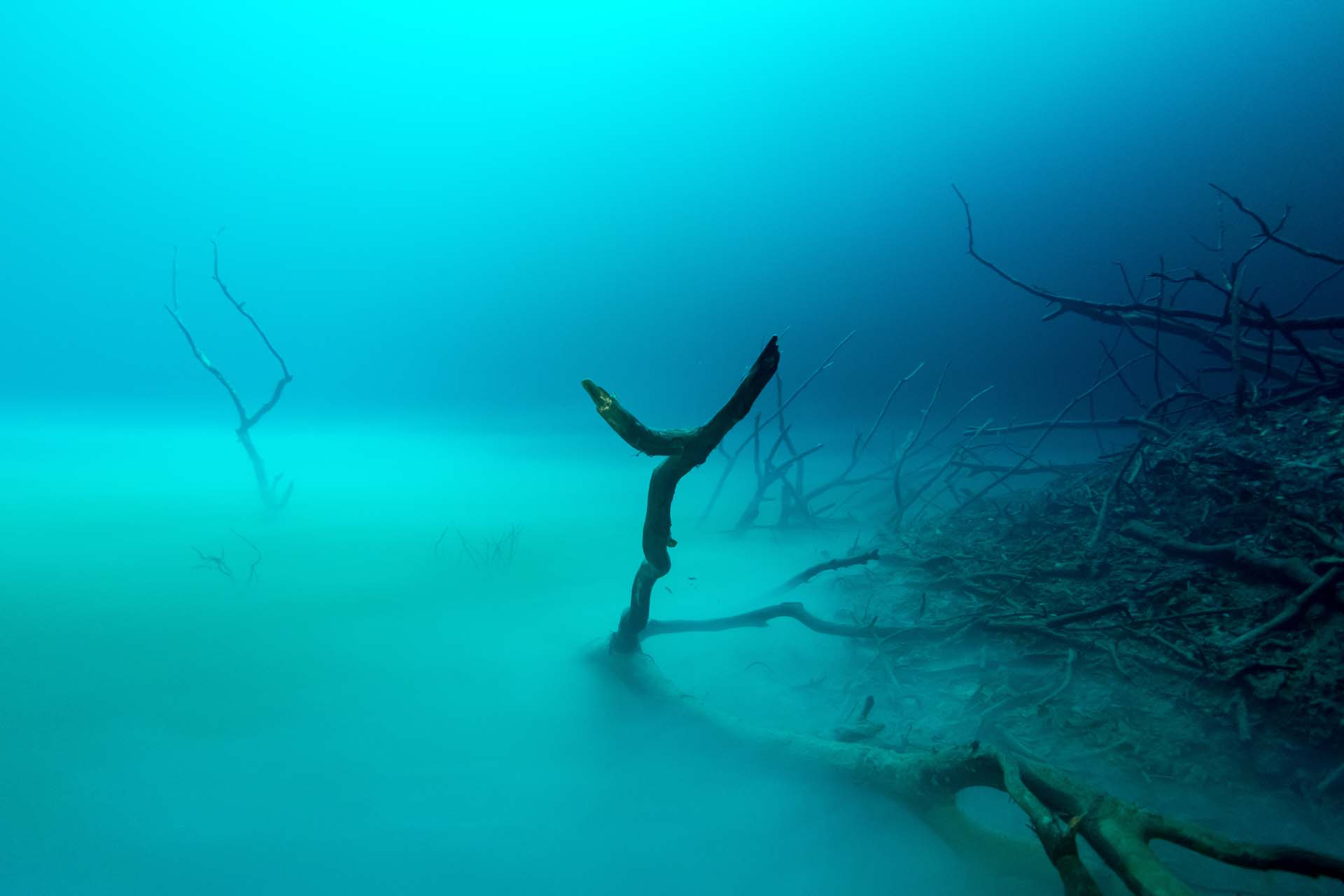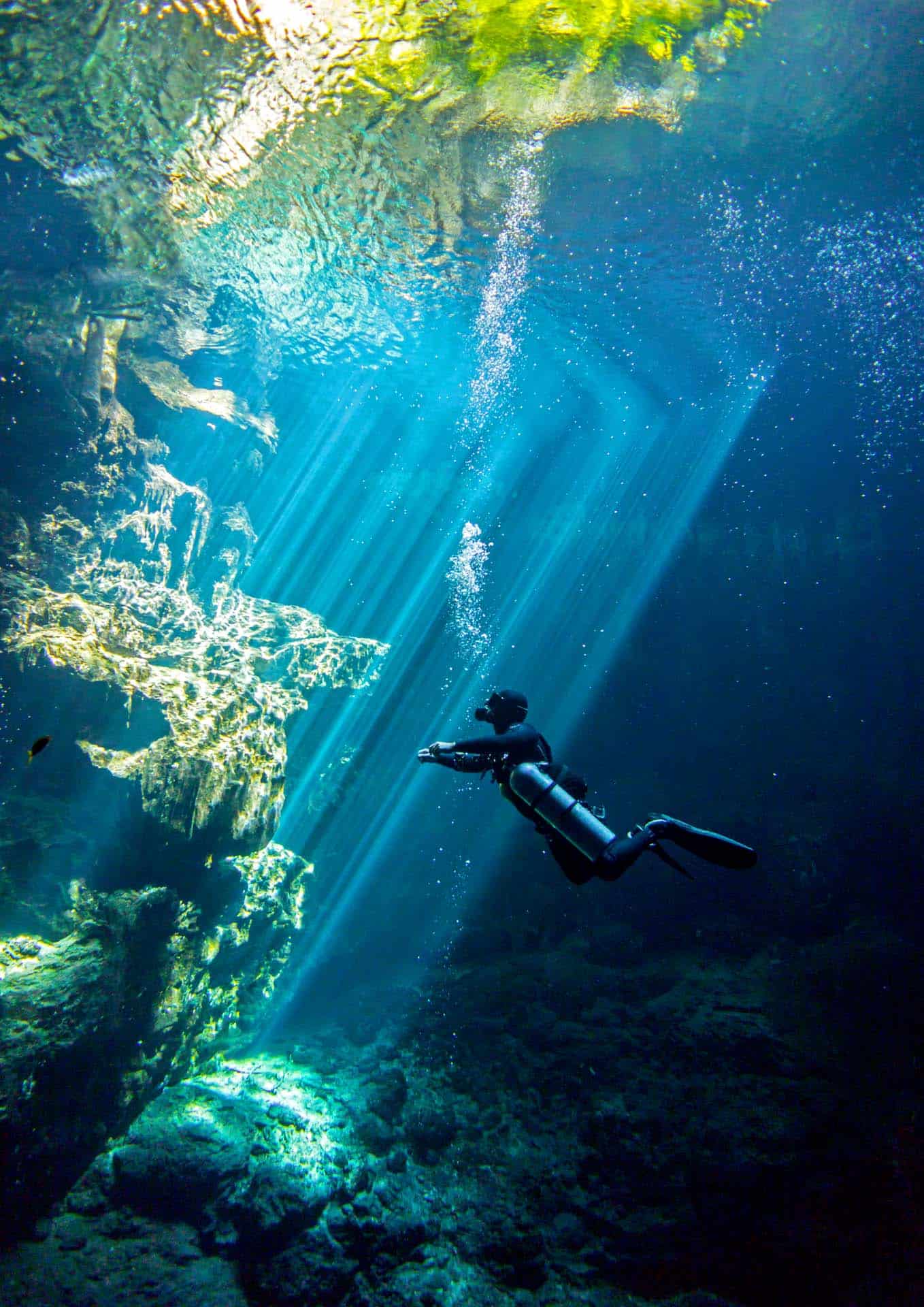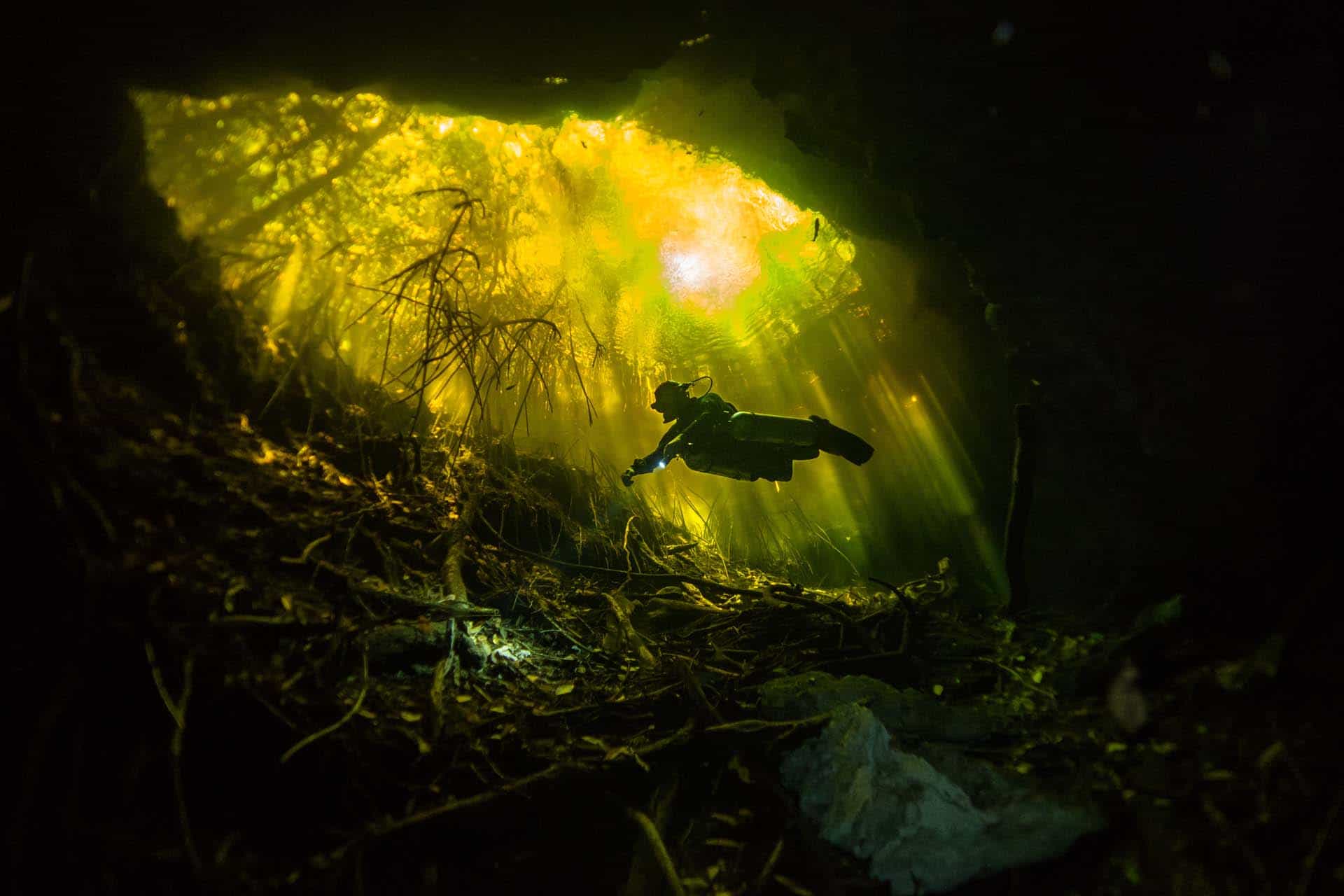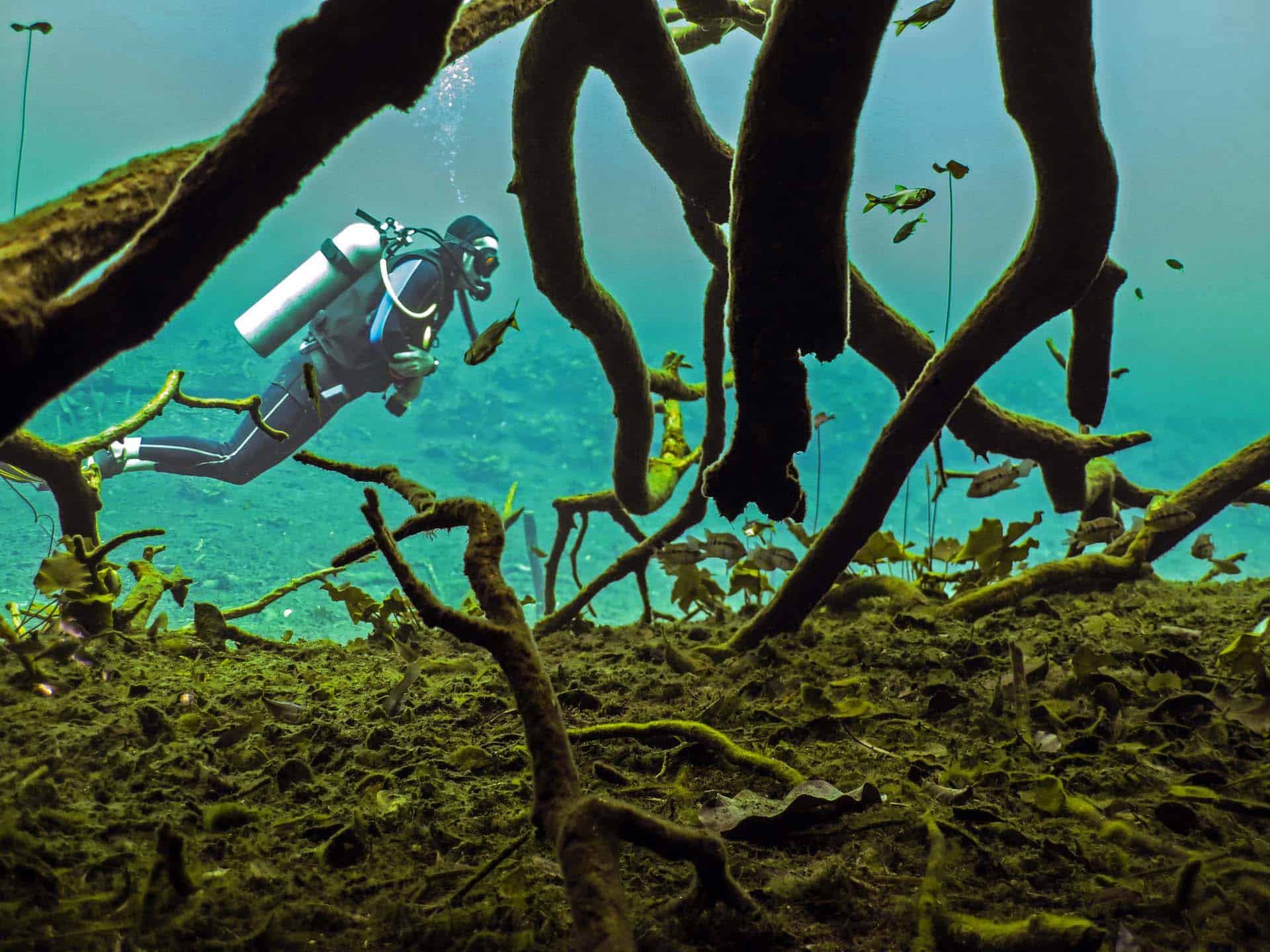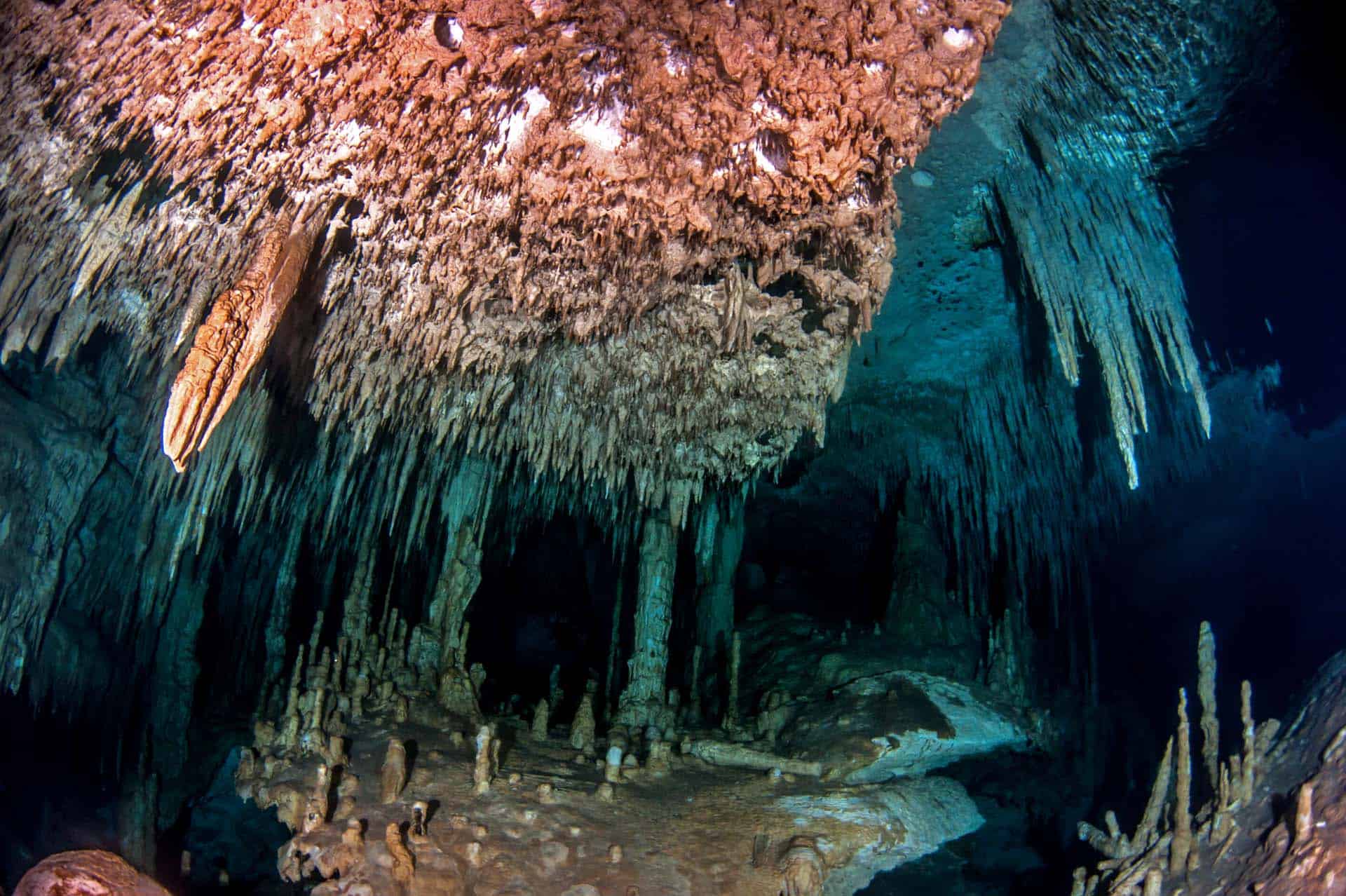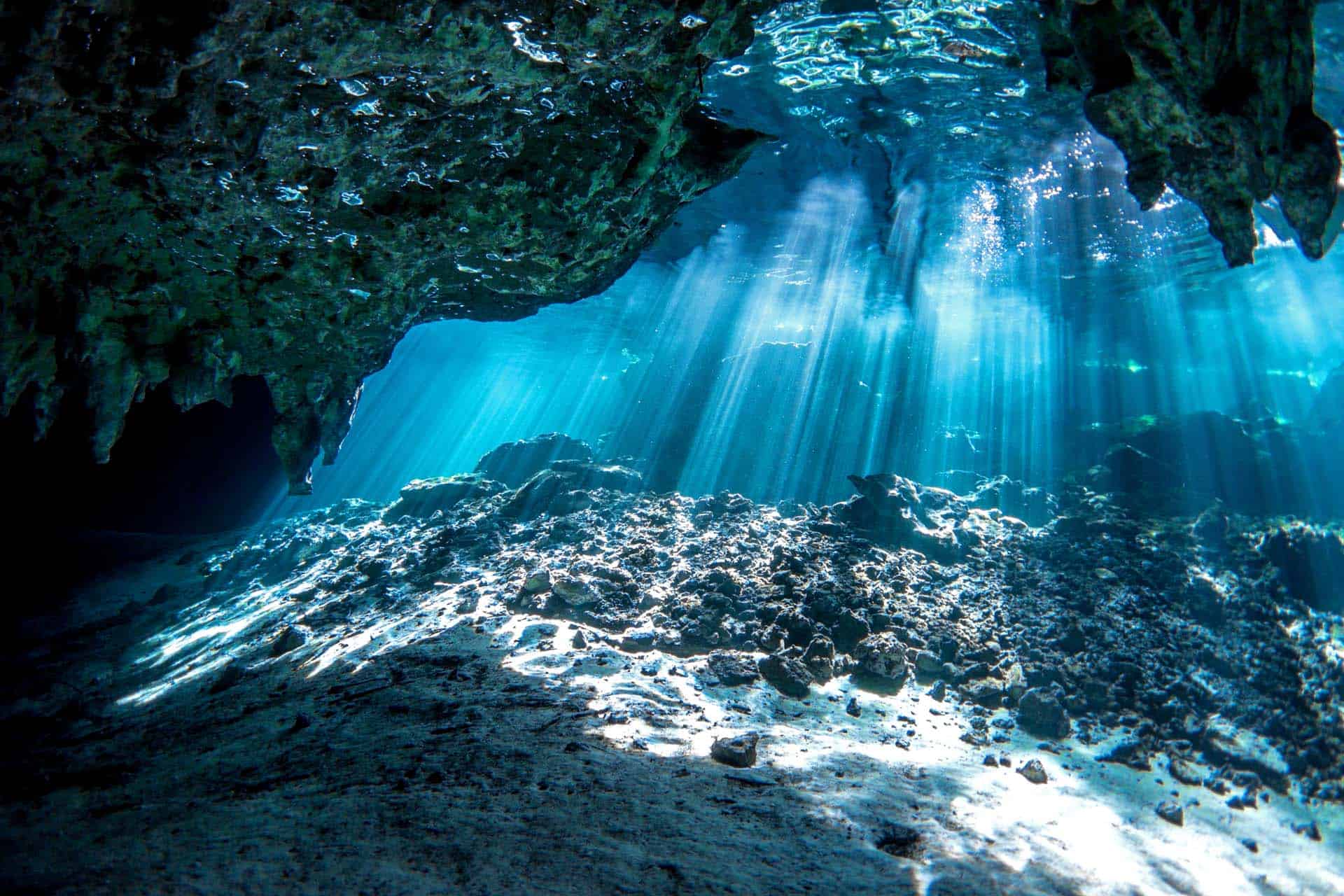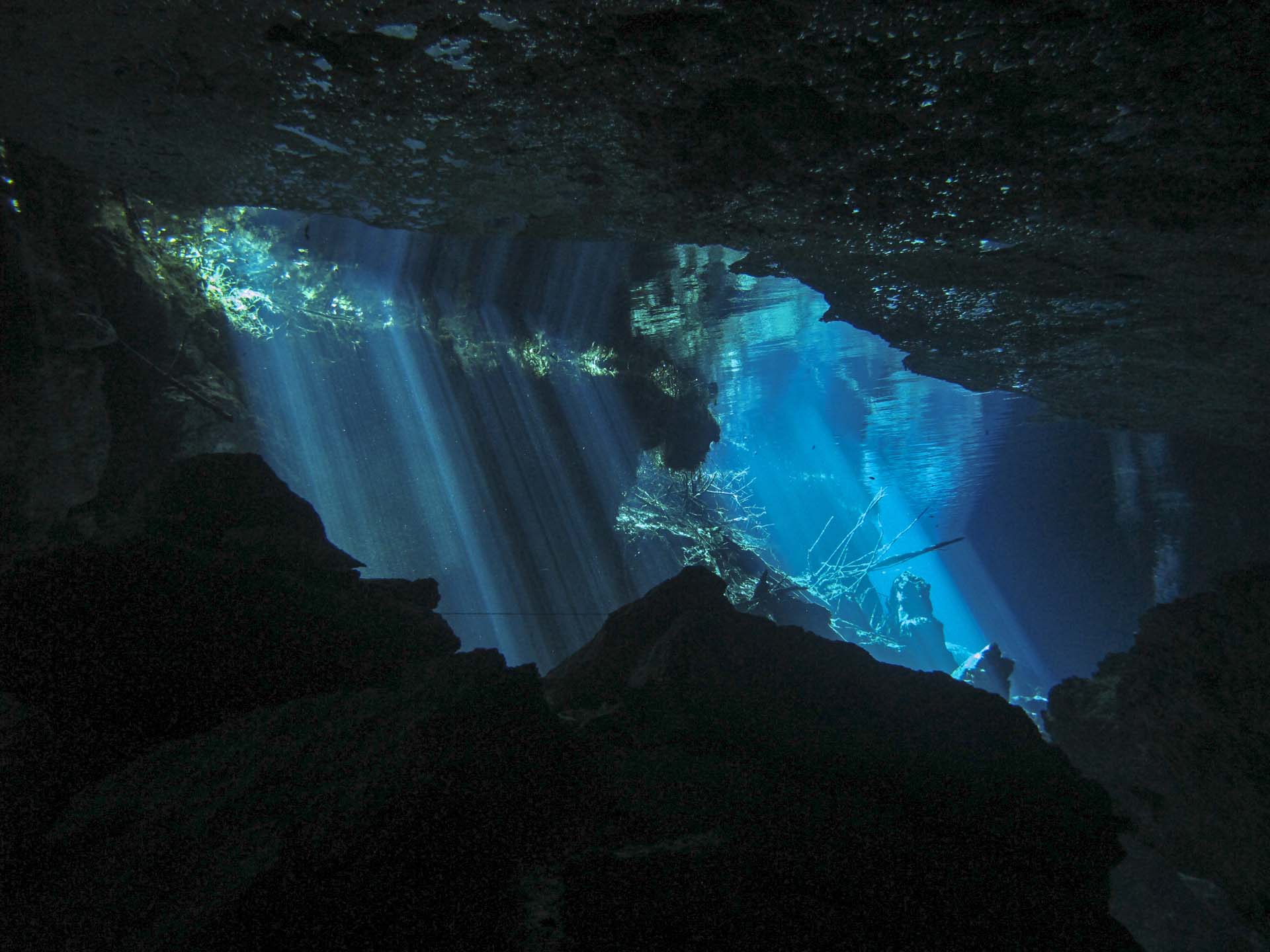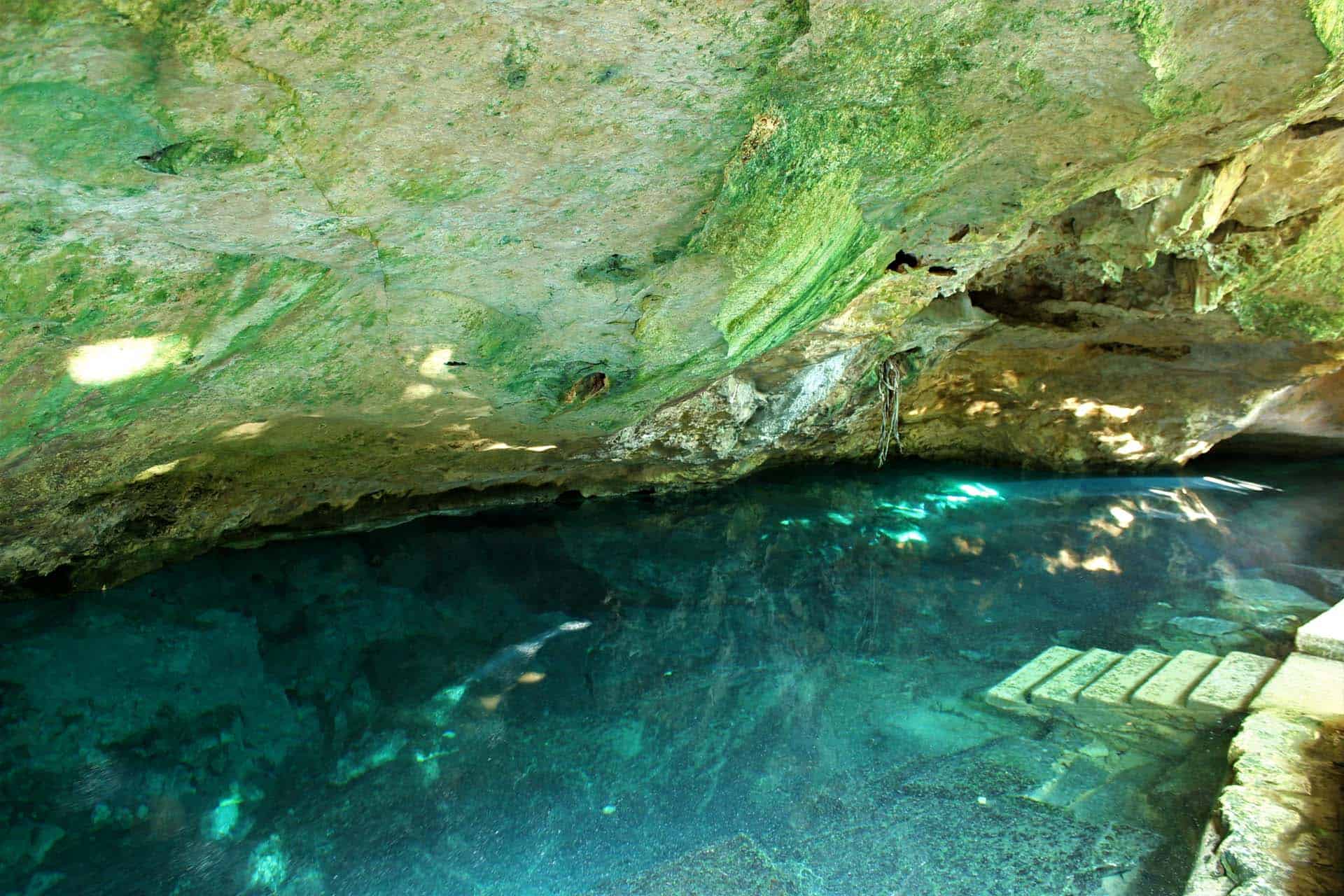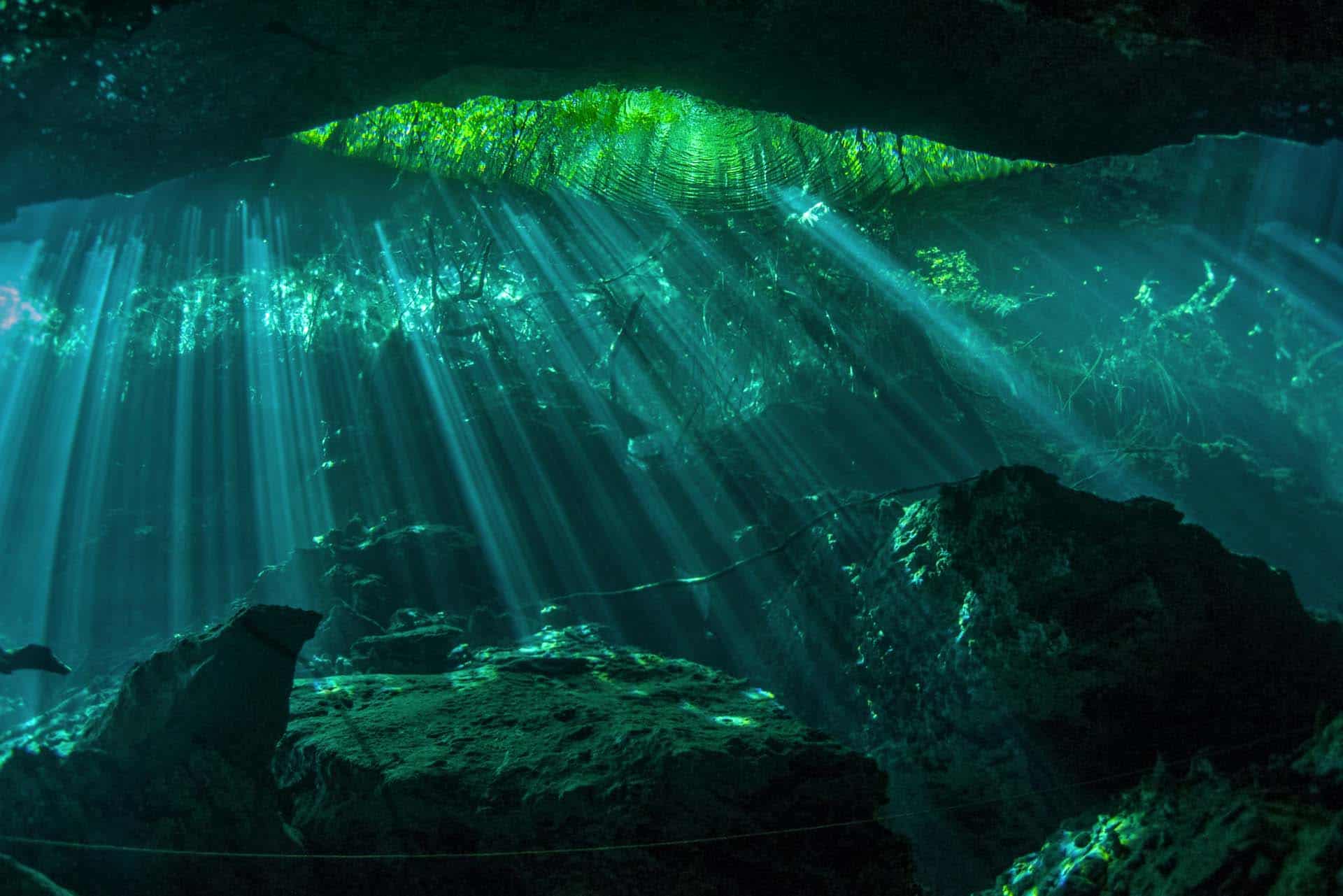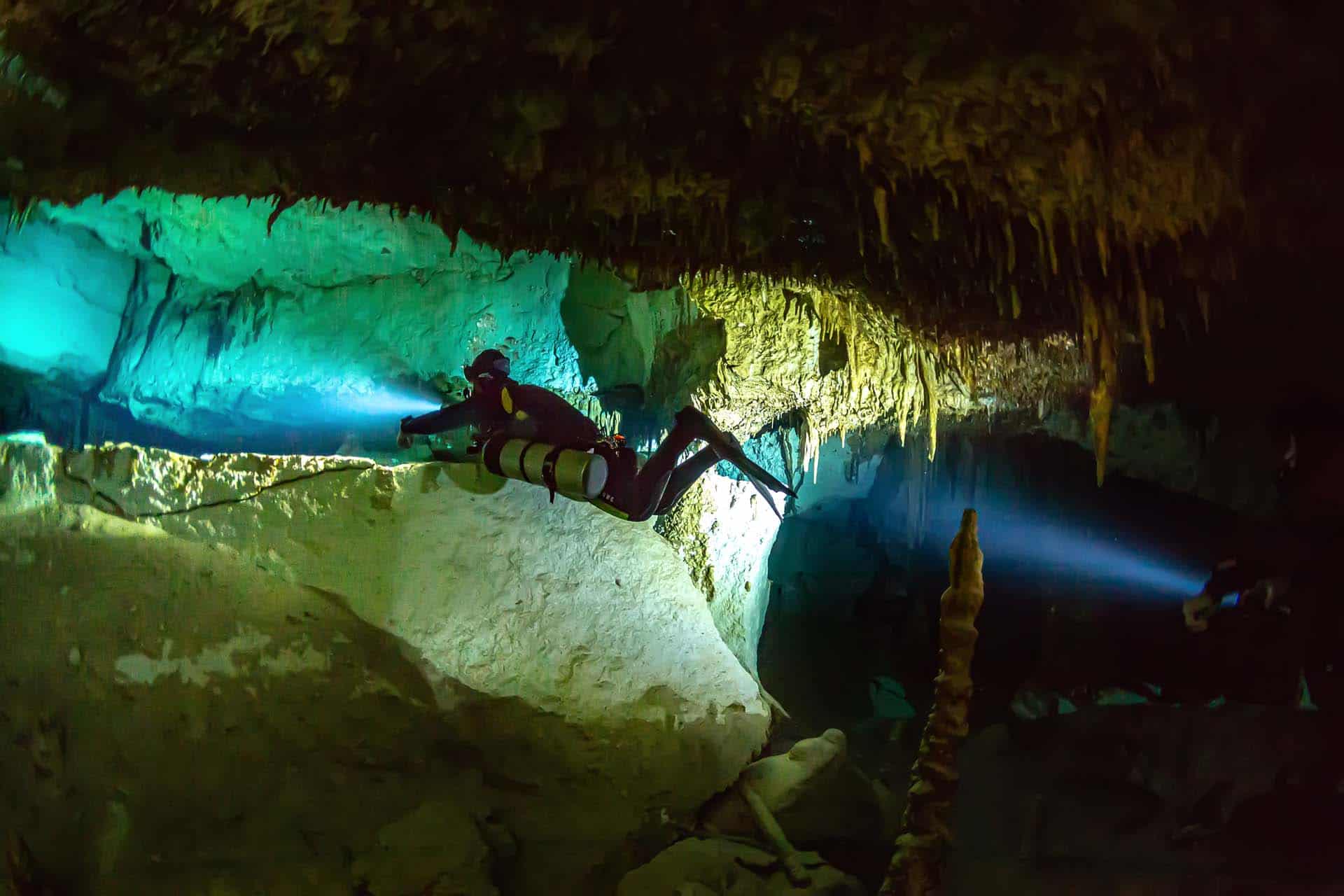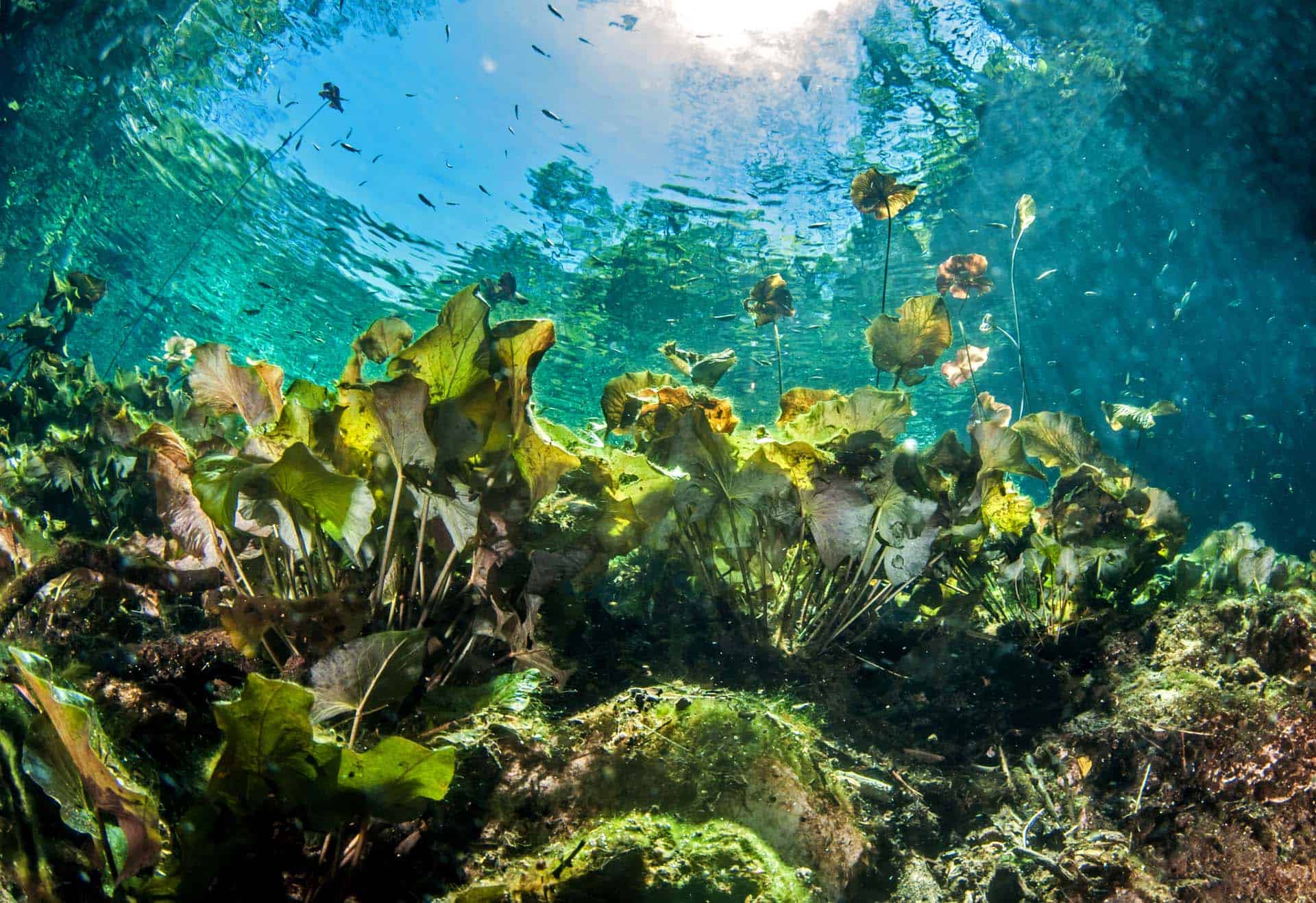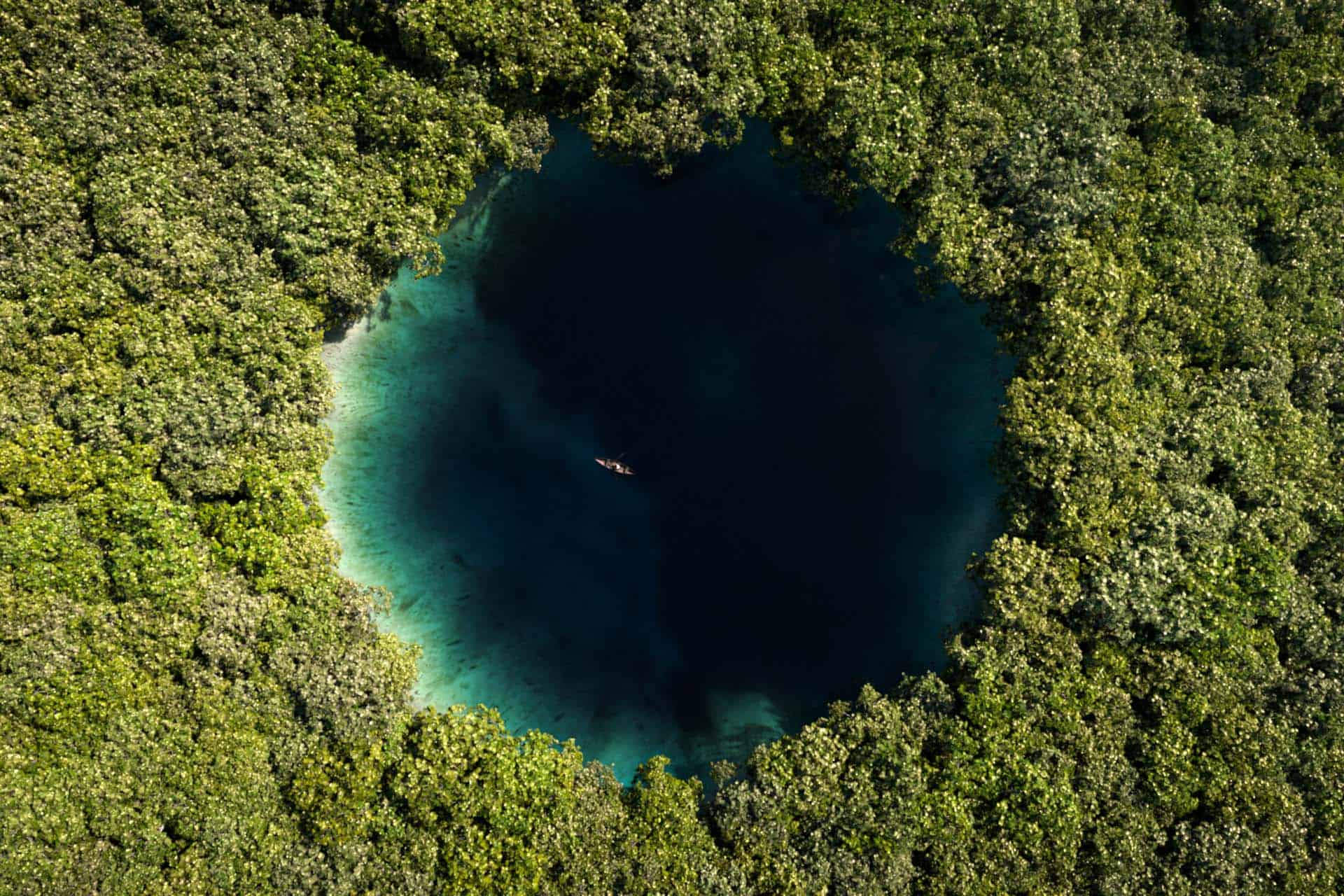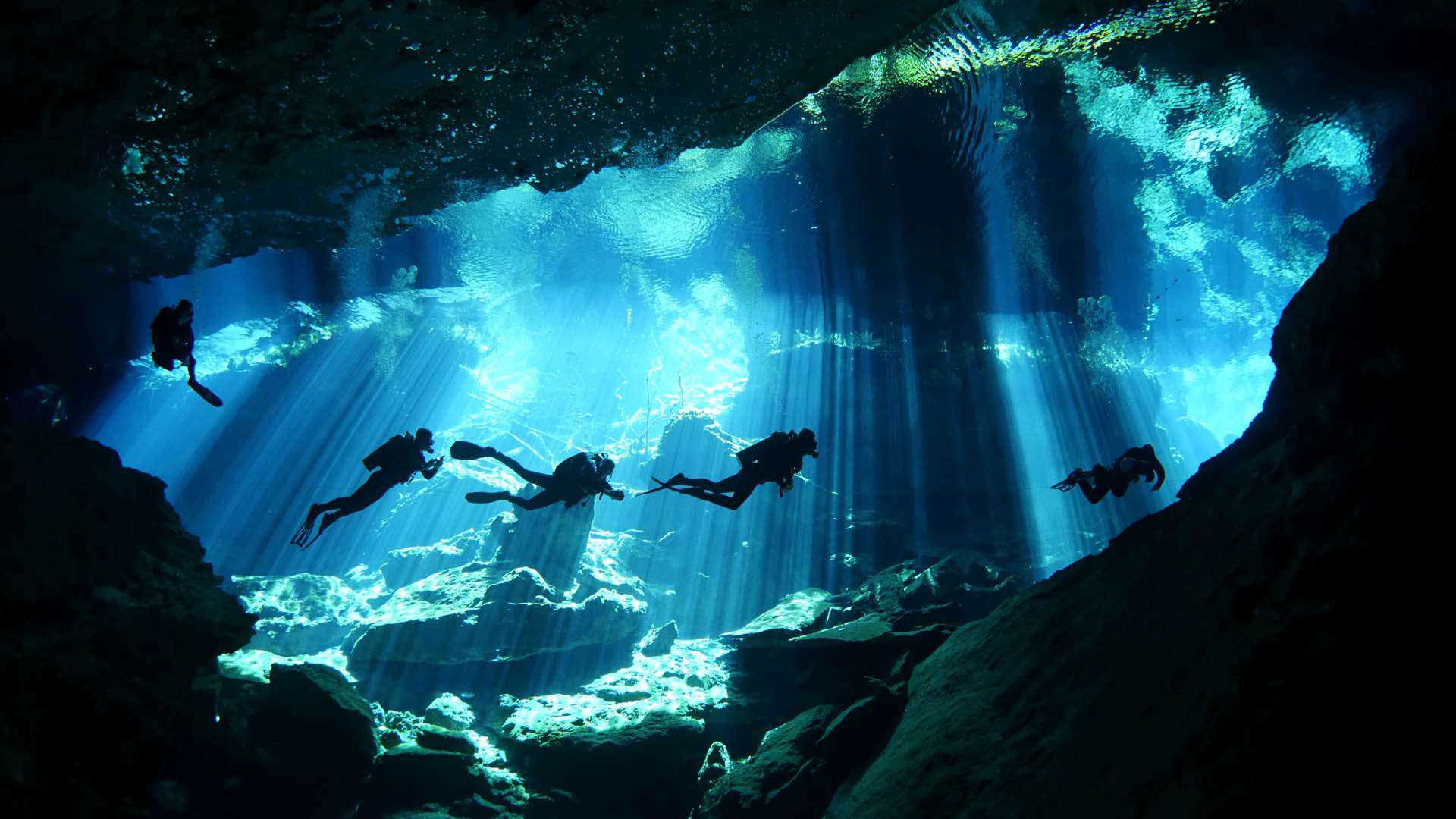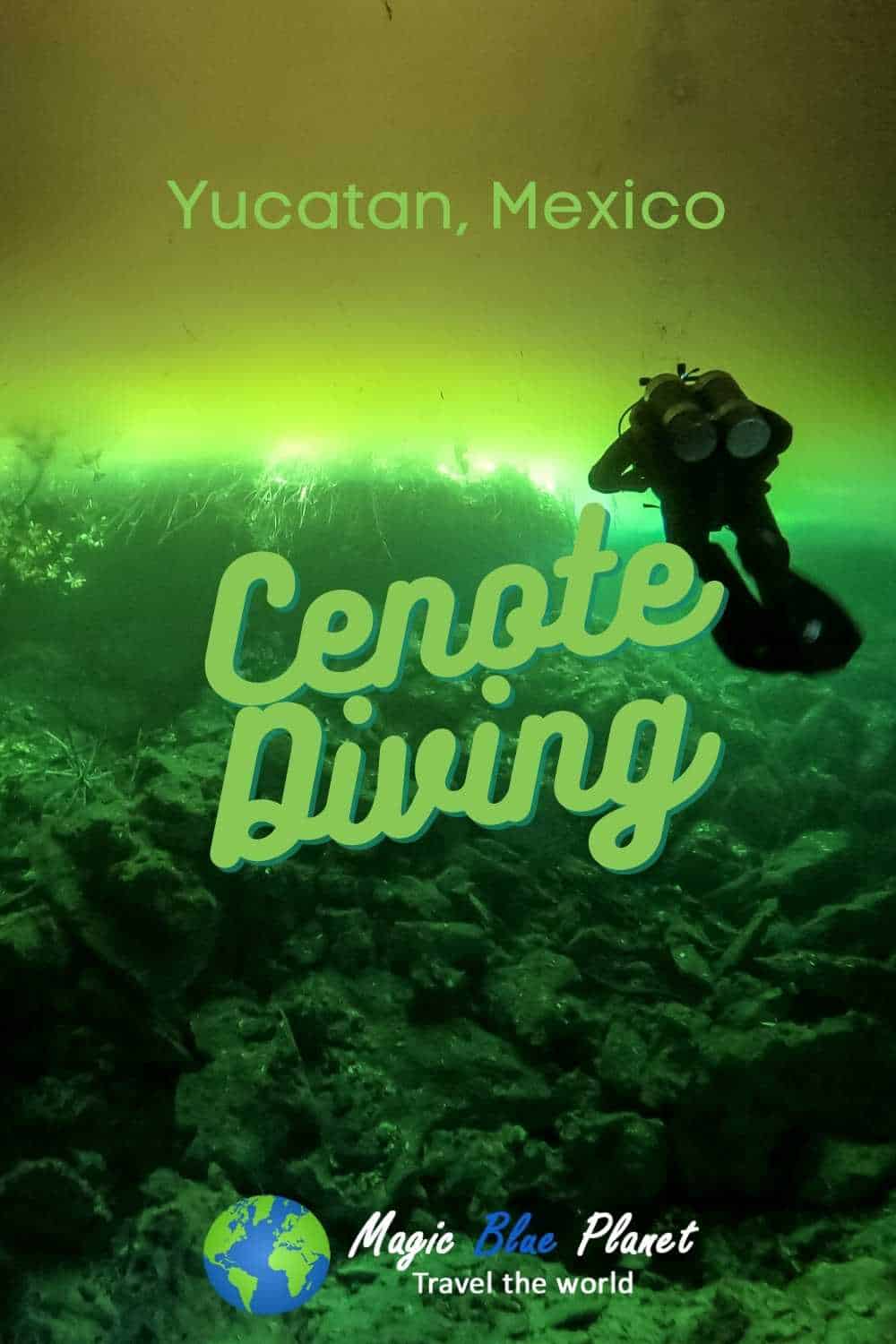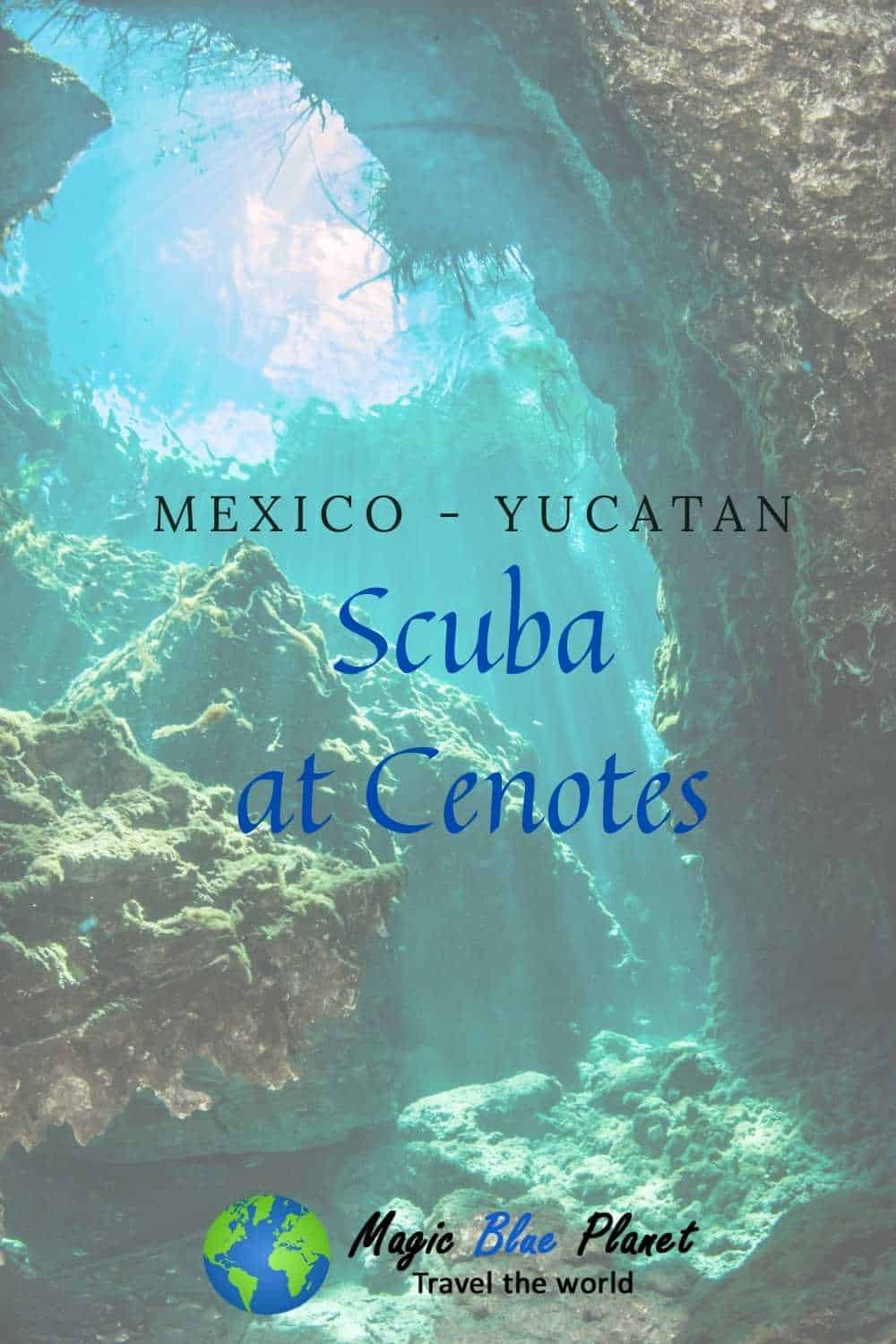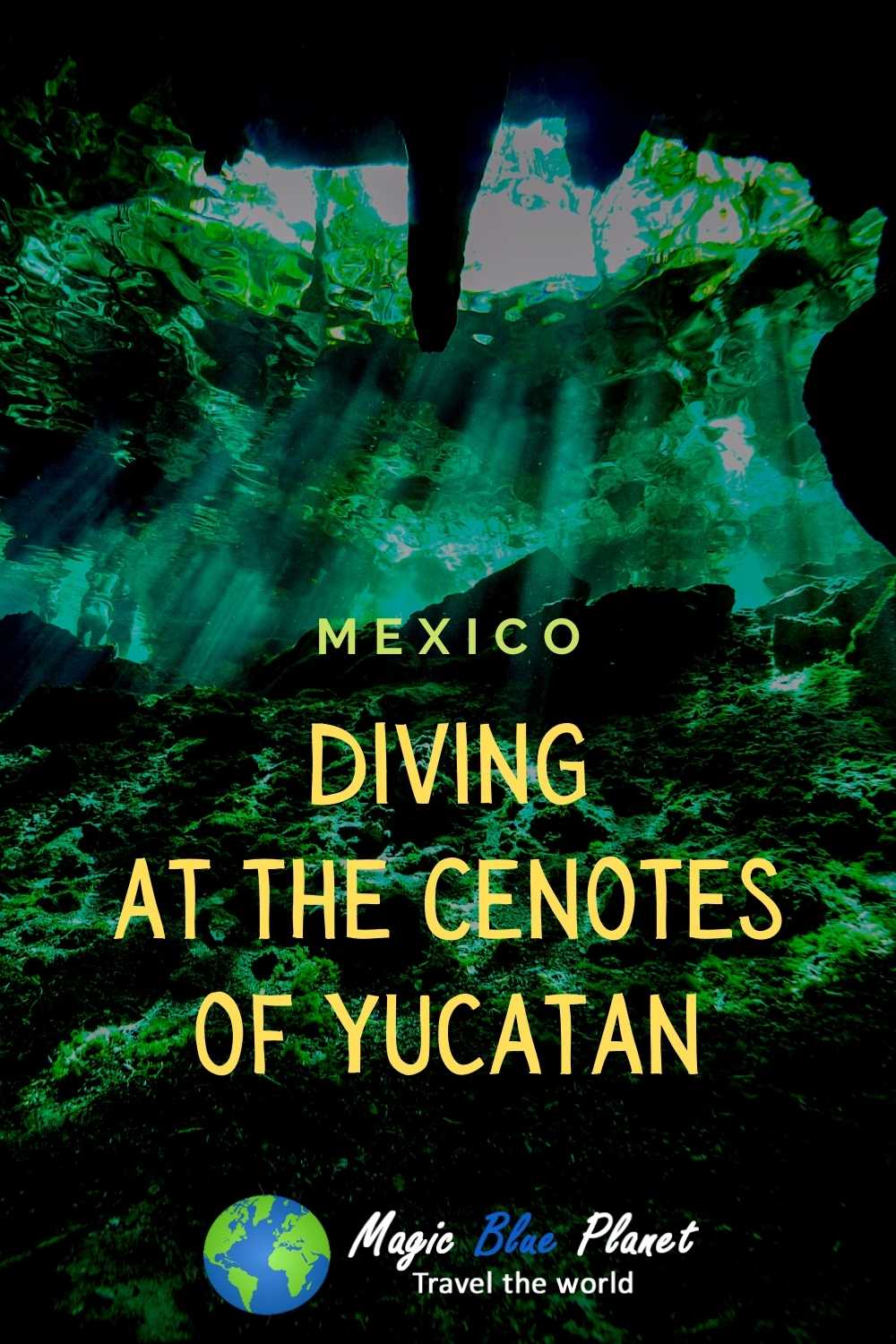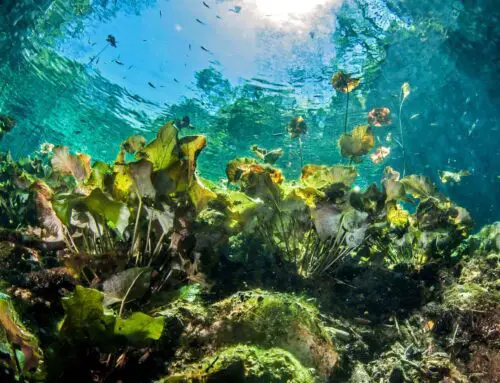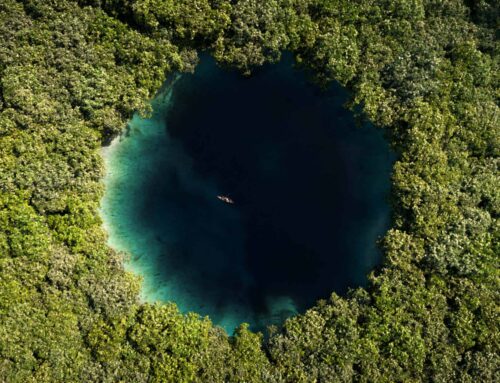Cenote Diving in Mexico – 16 spectacular dives
Cenote Diving in Mexico – 16 spectacular dives
Cenote Diving in Mexico – 16 spectacular dives
Diving in a cenote is like entering a secret, magical world. Crystal clear water, dark deep caves, bizarre forms of stalactites and stalagmites, limestone overhangs, from time to time a delicate ray of light that divides the darkness. Wow. The experience is completely different from diving in open water.
The Yucatan Peninsula in Mexico is the perfect place for this adventure. With more than 6000 cenotes, there is access to the largest known system of underwater caves on our planet. We have researched the most beautiful cenotes for diving for you.
Content: Cenote Diving in Mexico – 16 spectacular dives
What is a cenote?
Cenotes are sinkholes filled with water. They are limestone caves that have collapsed. Limestone erodes quite quickly, and then it can happen that the ceiling of the cave collapses and gives access to the subterranean waters. These are the so-called cenotes.
Some cenotes are wide open and only half filled with water. They are often visited for swimming, snorkeling, kayaking or zip-lining. There is a lot of fun and adventure for families and tourists. But in many locations, you can also experience incredible scuba dives.
Most tourists think cenotes is just a natural swimming pool. But this is perhaps an innocent way of looking at it. Many cenotes in Yucatan are linked to the largest known system of underwater caves on Earth.
The longest detected system to date is Sac Aktun with a length of 222 km. It is connected to the surface over 226 cenotes and has its lowest point in the Blue Abyss at 119 m depth. It is also connected to the system Dos Ojos further north by a dry passage.
With a total length of 372 km, Sac Aktun/Dos Ojos is the longest known system of underwater caves in the world. Closely followed by Ox Bel Ha with a length of 256 km, which is accessible over more than 140 Cenotes. In Quintana Roo, Mexico alone, more than 1000 km of underground rivers have already been explored.
Underwater conditions
The top layer of water in a cenote consists of fresh water. In the past, the Cenotes were therefore used by the Maya as drinking water wells. But this is only the top layer, further down there is salt water. Due to the different salinity, the two layers do not mix.
The boundary between fresh and salt water is called halocline. It is located in most cenotes at a depth of between 10 and 20 m and is clearly visible. It looks a bit like a mirror in the water. When you cross it, your vision will also become slightly blurred. But as soon as you arrive further down in the salt water, everything is back to normal.
A magical world awaits you there. As long as you stay in the caverns, you never completely escape from daylight. You discover overhangs and stone columns and can swim through passages.
One of the most beautiful things is the light plays in the crystal-clear water. And sometimes there are also remains of the ancient Maya, such as shards of clay or bone remains and fossils. An unforgettable experience.
And then there are the caves with their impenetrable darkness. They are reserved for the most experienced divers. Special training and special equipment are a basic requirement here.
Cavern diving is not cave diving
In the cenotes you will normally dive in caverns. It is an overhead environment with overhangs and passages for swimming through. But you will never be more than 40 m away from the surface and you will always see natural light. And of course, you will never dive into a cave.
This means you will never dive into a hole where you have to turn around to get out. Your guide is a trained cave diver with special equipment. He leads a maximum of four divers in the group. He will dive with more than one tank according to the safety standards. If not, then you should not dive with him.
By the way, in the cenotes of Mexico there is usually a stop sign somewhere under water. Behind it, the area that is closed for security reasons begins.
Unlike for cavern diving, you need special training for cave diving. You have to be over 18 years old and you should already have a lot of diving experience (Advanced Open Water). You also need an overhead certificate and at least 25 registered dives. For some caves, however, many more. You should cope with stressful situations and need special equipment.
By the way, if you’ve ever been a fan of freediving, then you should definitely dive in the cenotes. Here even confirmed scuba fans become enthusiastic free-divers.
Dangers of cenote diving
Unfortunately, hundreds of amateur divers are said to have died in the cenotes of Mexico. Namely when diving within the cave systems. Some of the underwater tunnels are extremely deep and long.
There is absolute darkness down there. And this can lead to a loss of orientation if you have no experience with dives in the dark. It can also sometimes be very difficult to see the guide lines attached for the safety of the divers.
Often it can get very tight. Your guide will never choose a way where two divers don’t get through next to each other. However, it can still easily create a feeling of claustrophobia that leads to unexpected panic reactions.
The surrounding rocks have very sharp edges. Movements or air bubbles of diving equipment can cause rock falls. When inexperienced divers stir up sediments, this can severely affect visibility.
Who can dive in a cenote?
Actually, every diver with a diving certificate. However, it would be helpful if you already had enough experience for a very good buoyancy control. Otherwise, you could bump into a stalagmite and damage it or even break it off. Remember – its creation took millennia and was only possible during an ice age when these caves were still above the water.
Furthermore, you should be good enough not to stir up the sediment with your fins. Otherwise, it decreases visibility enormously. As there is very little current, it takes a rather long time for it to sink again.
When is the best season to dive in the cenotes?
Cenote diving can be done all year round. On the beach and for diving in the sea, the best season in Yucatan is from October to April. In the Cenotes, however, you have the best visibility from May to October. Therefore, you can also take advantage of the low season with its cheaper prices.
By the way, most cenotes for diving have no public transport connection. But you can easily reach them with a rental car. Or you look for a guide on site who offers dives including arrival.
The 16 best cenotes for diving on the Riviera Maya
Each cenote is unique and beautiful in its own way. Therefore, you have a great variety of suitable dive sites to choose from. But of course, there are some locations that are particularly popular with divers. Here are some cenotes that are highly recommended on the Riviera Maya for diving.
1. Cenote Dos Ojos
Cenote Dos Ojos is located north of Tulum and it is very famous. It can also get quite crowded here. But it’s still a great diving spot. You can do two different dives here. The stalagmites in Dos Ojos are often white and incredibly beautiful and delicate. And there is a hidden bat cave with fresh air where you can surface and watch the bats.
2. Cenote Calavera
Cenote Calavera (“dead skull”) has its name from the three holes in the ceiling. There are not so many rock formations here, but beautiful light effects at the entrance and a very pronounced halocline. The access can be done via a ladder or via a jump from the edge into the water 2 m lower.
3. Cenote Angelita
Cenote Angelita is also an insider tip among divers. At a depth of about 30 m, there is a layer of clouds on the halocline, where people seem to disappear. Underneath, the water is dark and full of dead trees. The cloud actually consists of hydrogen sulfide that bacteria produce when the dead plants are decomposed.
Cenote Angelita has the shape of a well shaft, in which one dives about 30 m downwards. On the ground there is a hill of rock and sediment from the ceiling collapse, the top of which forms a small island above the halocline with its cloud. Cenote Angelita is also great for freediving.
4. Cenote El Pit
Cenote El Pit is only suitable for very experienced divers. This is due to its depth of 119 m, it is the deepest cenote in Quintana Roo discovered so far. This cenote has only a few overhangs and convinces with crystal clear water and spectacular light effects up to 30 m depth.
At 15 m you will find a great halocline and at 30 m a layer of hydrogen sulfide. The remains of many wildlife and spectacular white stalactites on the ceiling make a dive in El Pit an almost unreal experience.
5. Cenote Tajma Há
The dive at Cenote Tajma Há actually leads through several cenotes: Tajma Há has a spectacular halocline and is especially great for taking photos. An intense curtain of light awaits you at the Sugar Bowl, and at Cenote Esmeralda green rays of light fall in, because its water is colored green by tannins.
Here you can also get your first experience for cave diving. But you should have perfect buoyancy control for this dive. The rock formations here have very sharp-edged profiles.
6. Cenote Car Wash (Aktun-Há)
The name of Cenote Car Wash is actually Cenote Aktun-Há. But in the past, the region’s taxi drivers always washed their cars here, so it’s called Car Wash. However, the name is misleading – it is probably one of the most beautiful cenotes for snorkeling and freediving.
The cenote with a diameter of about 50 m has clear green water, dead trees and beautiful flowering gardens under water. There are fish and turtles, and even a friendly little crocodile is living here. By the way, Cenote Car Wash is a great place for photographers.
7. Cenote Dream Gate
Cenote Dream Gate is very popular with divers for its spectacular rock formations. But it can also get a bit tight here, therefore it is only suitable for experienced divers with excellent buoyancy control.
This very shallow cenote is hidden in the middle of the jungle about 1 km south of Cenote Dos Ojos. The lush stalagmites here are extremely delicate and the sediment very fine. Two different dives can be done – upstream and downstream. The dives at Cenote Dream Gate are ranked among the most beautiful in the world by divers.
8. Gran Cenote
Gran Cenote is located about 4 km outside Tulum and was once the main access to the Sac Aktun cave system with its more than 200 km in length. Wide passages, spectacular rock formations and beautiful lighting effects await you here. At the entrance there is also a lot of wildlife, up to small freshwater turtles.
9. Cenote Chac Mool
Cenote Chac Mool is located in Puerto Aventuras, 23 km south of Playa del Carmen. The dive starts in the neighboring Cenote Little Brother, which is connected to the Cenote Chac Mool via a small tunnel.
The light at the entrance is beautiful, as is the halocline. At Cenote Chac Mool, a cathedral with air awaits you, where you can surface. There are great stalactites and cave animals to watch.
10. Cenote Kukulkan
Cenote Kukulkan is located near Cenote Chac Mool and belongs to the same cave system. Here you will find a good infrastructure up to a small restaurant. And the cenote is so beautiful that it is featured in many diving magazines.
This dive offers an incredible light show. The sun’s rays fall through the entrance of the cave and draw great light effects into the crystal-clear water. There are also fossils, crystals in the cave walls and a striking halocline to be seen.
11. Cenote El Jardin del Eden (Ponderosa)
The Cenote El Eden, also called Ponderosa, is a spectacular place for photographers. The dive leads from the entrance in El Eden to the even larger neighboring Cenote Coral. There is a beautiful curtain of light, with meter-long roots of mangroves in the background.
You swim through a large tunnel, where you can see many cave entrances and a spectacular halocline. There are also fossils and ceramics of the Maya. At the entrance there are many fish and also turtles, this area is also very popular for snorkeling.
12. Casa Cenote
Casa Cenote, also known as Cenote Manatee, is located about 10 km north of Tulum directly besides the beach. In fact, it is located in a hotel area and is often visited by guests. Therefore, you will find an excellent infrastructure here.
Casa Cenote is separated from the sea only by the beach. Actually, it is even directly connected to the sea – through a 50 m long tunnel under the beach. The Cenote is located in the middle of a mangrove forest. There is a lot of flora and fauna and great lighting effects to see.
The surroundings are absolutely idyllic, and diving in the sea and cenote at the same time has a very special charm. Casa Cenote is also ideal for beginners who want to gain their first experience in diving.
13. Cenote Tak-Be Há
Cenote Tak-Be Há is located like some others in the eco-park Dos Ojos and it is just the place if you want to fall in love with the quiet water inside a grotto. The cave is beautifully illuminated with headlights in an almost magical way.
Right after the rather small entrance, wonderful stalactites and huge tree roots await you in a large grotto. The Cenote Tak-Be Há is also a great experience for snorkeling or swimming. But it is not so crowded because it is a bit remote and offers hardly any infrastructure. For a dive here you need a certificate for cave divers.
14. Cenote Nicte-Há
Cenote Nicte-Há is also located in the Dos Ojos eco-park north of Tulum. The name Nicte-Há comes from the Mayan language and means “water flower”. And in this cenote also grow beautiful plants, which is why it is very popular to take great photos.
There are also impressive stalactites and stalagmites. The light effects in this cenote are incredibly beautiful. Due to the fine sediment, this dive is only suitable for experienced divers.
15. Cenote Chikin Há
Cenote Chikin Há is located south of Puerto Aventuras near Ponderosa and is connected to many other Cenotes. It is therefore not only suitable for cavern diving, but also for cave diving and for the necessary training. Since the Cenote is also very popular for snorkeling, there is also a very good infrastructure.
You reach the water via a stone staircase – or by jumping into the cool water. Here you can either do two dives of 45 – 60 minutes each or a long dive. Both routes lead to Cenote Arcoiris (“Rainbow”).
There are wonderful light effects, a great halocline and spectacular white rock formations. You can surface between the roots of the tropical trees and watch the birds. And looking up quickly reveals why the second cenote is called “Arcoiris“.
16. Cenote Sac Aktun (Pet Cemetery)
Cenote Sac Aktun was called “Pet Cemetery” by its explorer because of the many animal bones deposited there. Among the bones are even the fossils of a prehistoric camel. The Cenote is hidden deep in the jungle north of Tulum.
The cenote is very shallow and abundantly decorated with incredibly beautiful, fine rock formations. It is only suitable for excellent divers with a certificate for cave diving.
From Cenote Sac Aktun, a dive of about 50 – 60 minutes leads over the Díaz Line to the famous Blue Abyss. It bears its name for two reasons: The water has an incredibly spectacular blue color. And with a depth of 119.2 m, it is the deepest part of the longest known underwater cave system in the world.
Conclusion
Did you find your favorite cenote in our suggestions? If you’re an enthusiastic diver, you’ll probably try several locations. And you will certainly live some unique experiences. Have a wonderful time!
Attention!
This text in informational only. It was written on the basis of research and may be inaccurate. Always contact local professional divers before diving.
Related Posts
You might also be interested in this

